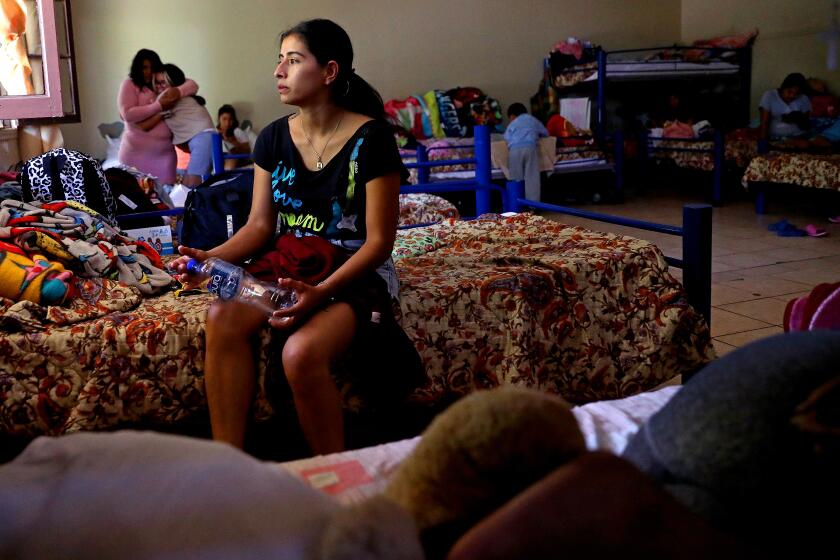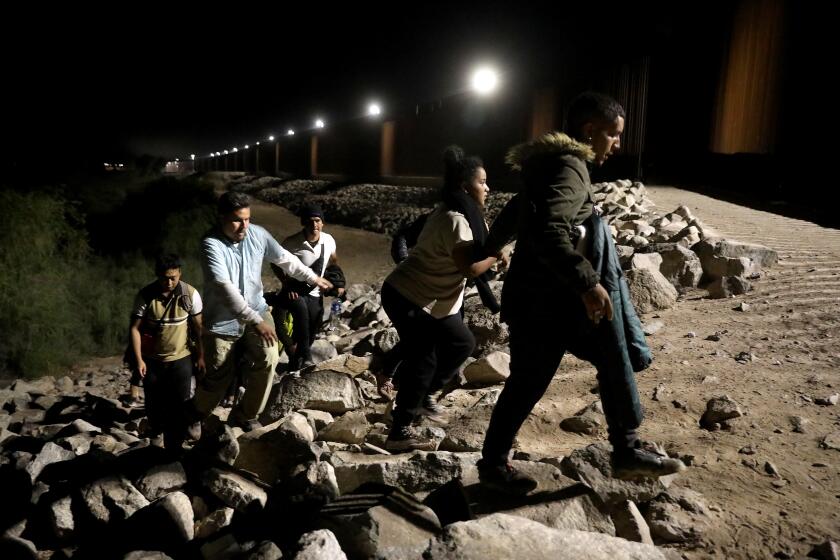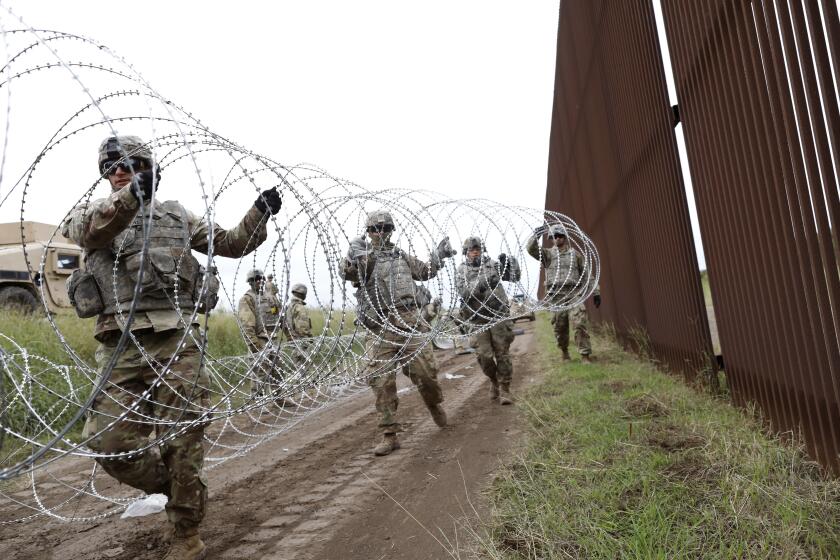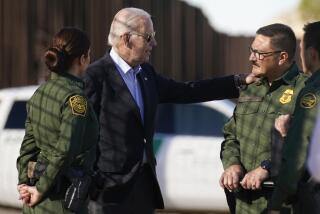What is Title 42 and what happens now that the immigration policy has expired?

Title 42, the policy used to keep asylum seekers out of the U.S. during the pandemic, expires tonight, ushering in a new era for U.S. border control.
- Share via
WASHINGTON — Title 42, a decades-old public health statute used during the COVID-19 pandemic to keep asylum seekers out of the U.S., lifted at 8:59 p.m. PST on Thursday, ushering in a new era for U.S. border control.
Orders under Title 42 were first implemented by the Trump administration in March 2020 and met with legal and political challenges, but remained in place through President Biden’s first years in office.
Citing the threat of COVID-19, the U.S. government has over the last three years carried out nearly 2.8 million expulsions of migrants at the border without offering them the opportunity to request asylum. Title 42 drove border crossings up to record levels, in part because the nature of rapid expulsions made it easier for people to immediately attempt crossing again.
Title 42 left a lasting imprint, with restrictions never before seen at the border and uncertainty about the weeks to come.
Here’s what you need to know.
What is Title 42?
Title 42 is a public health and welfare statute enacted in 1944 that gave the U.S. surgeon general the authority — later transferred to the Centers for Disease Control and Prevention — to determine whether communicable disease in a foreign country poses a serious danger of spreading in the U.S., either by people or property entering the country.
If the CDC finds that a disease poses a threat, it can, with approval from the president, temporarily prohibit people from entering the country to avert danger.
That’s what happened at the beginning of the COVID-19 pandemic. In March 2020, amid surging deaths from the virus, the Trump administration put forward a novel interpretation of Title 42: U.S. Customs and Border Protection agents could immediately remove anyone entering the country without authorization to prevent the spread of the coronavirus. That action closed the border to nonessential travel in the “interest of public health.”
Across the southern border with Mexico on Wednesday, communities, migrants and border agents braced for the long-anticipated end of Title 42 orders. Most U.S. Customs and Border Protection facilities were already overcapacity.
But it also superseded all other U.S. laws, including statutes that grant migrants the right to seek asylum; prevent the persecuted from being returned to countries where they would face threats, harm or torture; and protect unaccompanied children vulnerable to being trafficked.
How was Title 42 implemented?
Title 42 appears to have been first applied by the CDC under pressure from former Vice President Mike Pence, and from Stephen Miller, a top Trump aide who long sought to restrict immigration. Experts at the CDC objected, saying the policy would do little to stanch the spread of the coronavirus and that it could not be justified in the name of public health.
Advocacy groups including the American Civil Liberties Union sued the Trump administration over the policy. When President Biden took office, the new administration continued the policy, saying it was “necessary to limit the spread of the coronavirus.” The policy survived challenges to its constitutionality.
The Biden administration later exempted children traveling without a parent from being subject to expulsion under Title 42. Parents traveling with their children and single adults continued to be blocked from entering the country or quickly expelled. But children traveling with extended family members, such as grandparents, are not considered family units and could be separated at the border, with the children labeled as unaccompanied minors and allowed to enter.
In Tijuana, migrants wait in an area between two layers of border wall that has become an open-air holding cell for the U.S. Border Patrol.
Why has Title 42 generated controversy?
Legal experts have characterized Title 42 as one of the most controversial and restrictive immigration policies in U.S. history. Lawmakers including then-California Sen. Kamala Harris called it an unconstitutional “executive power grab.” Immigrant advocates broadly expected Biden to do away with enforcement of the measure when he took office.
Public health experts said it was people who refused to get vaccinated, not migrants, who drove the increase of COVID-19 infections in the U.S. Former CDC officials wrote a letter to the Biden administration condemning the policy as “scientifically baseless and politically motivated.” Dr. Anthony Fauci, then the nation’s top infectious disease expert, condemned it.
But even as some restrictions on non-essential travel at land ports of entry were lifted, the Biden administration continued to justify Title 42 as necessary to protect migrants, the Department of Homeland Security workforce and local communities.
The advocacy group Human Rights First documented more than 13,400 violent attacks on asylum seekers stuck in Mexico during Biden’s first two years in office.
How has Title 42 worked?
Under Title 42, migrants were not formally deported, a process that can come with consequences such as a five-year ban from the U.S. and criminal prosecution. Instead, agents took migrants’ biometric information and within hours returned them to Mexico or flew them back to their home country.
For decades before the implementation of Title 42, migrants who made it to the U.S. and sought asylum or other humanitarian protections were detained or released pending a final immigration court decision. But that could take years amid an ever-growing backlog of cases.
Among nearly 5.6 million people detained by the CBP at the southern border since March 2020, roughly half were expelled under Title 42, according to CBP figures. But those rapid expulsions caused an uptick in repeated crossing attempts by migrants who were returned to Mexico, inflating the number of individuals encountered. In March, around a quarter of the arrests were of people who had previously been turned back within the same year.
Migrants can also be screened under the United Nations Convention Against Torture. Those screenings, in which individuals must prove that they are likely to be tortured if they are expelled, are more difficult to pass than traditional asylum interviews.
Federal officials relied on Mexico to receive expelled migrants from parts of Latin America and the Caribbean. Those who were refused by Mexico and could not be immediately expelled entered the U.S. and faced a longer deportation process.
What will happen now that Title 42 has been lifted?
Migrants who seek asylum will be required to use a mobile phone application, CBP One, to make an appointment to be interviewed by border agents. The app had been riddled with technical glitches and offers limited appointments — 1,000 per day — that fill up within minutes. CBP has said it has fixed the technical issues and that it will begin to prioritize people who have waited the longest for appointments.
On Wednesday, the Biden administration finalized a rule that would largely make migrants ineligible for asylum if they enter the U.S. without permission and fail to apply for protection in another country on the way.
The DHS said it will rely significantly on the fast-tracked “expedited removal” process after May 11 to assess migrants’ claims for relief and deport those who don’t qualify within days or weeks. Families will be subject to GPS monitoring and curfews while their cases are decided. Mexico agreed to continue accepting some deported migrants who are not from that country after Title 42 expires.
Biden to send 1,500 active-duty soldiers to U.S.-Mexico border before Title 42 order expires. About 2,500 National Guard members are already there.
The administration is pairing enforcement with some humanitarian pathways. One allows citizens of Venezuela, Haiti, Nicaragua and Cuba to apply for temporary lawful entry under humanitarian parole if they have a financial sponsor, so long as they don’t attempt the journey without authorization.
U.S. officials plan to set up 100 processing centers throughout the Western Hemisphere, starting with two in Guatemala and Colombia, to prescreen migrants for refugee eligibility and other legal pathways. Officials noted it would be “weeks” before the first two processing centers open. Another program still in the works will reunite families from El Salvador, Guatemala, Honduras and Colombia, as well as those from Cuba and Haiti, who have pending permanent residency (so-called green card) petitions.
Some of these provisions are likely to be challenged in court. Republican-led states have already sued to block the parole program, and advocates such as the ACLU are expected to sue over the asylum ineligibility rule.
What has it been like at the southern border leading up to May 11?
Arrivals at the U.S.-Mexico border in the waning days of Title 42 orders have strained Customs and Border Protection sectors, especially in Texas. Last week in McAllen, Texas, Border Patrol agents told reporters that 6,000 migrants — most of whom came from Venezuela — were in custody at various facilities and noted that the numbers were well above the Rio Grande Valley sector’s capacity of 4,600. Agents expelled groups of migrants to Mexico three times a day.
Border Patrol agents had apprehended more than 10,000 migrants Tuesday across the southern border, according to internal data obtained by The Times, already reaching levels predicted by U.S. officials for immediately after the policy lifts.
DHS has expanded detention capacity at the border and inside the U.S., and has shifted agents to high-traffic areas on the border. The agency launched targeted enforcement operations this week in places including El Paso to quickly deport migrants who entered the U.S. without permission and have no legal basis to stay.
Times staff writers Karen Garcia and Hamed Aleaziz contributed to this report.
More to Read
Get the L.A. Times Politics newsletter
Deeply reported insights into legislation, politics and policy from Sacramento, Washington and beyond. In your inbox three times per week.
You may occasionally receive promotional content from the Los Angeles Times.














